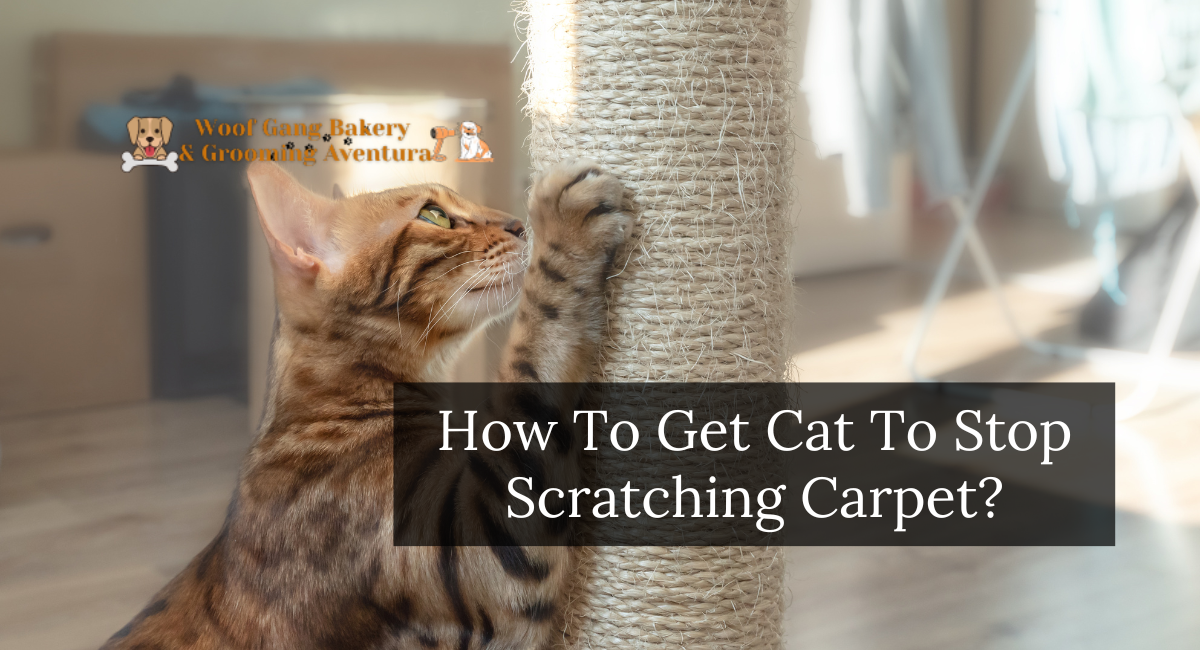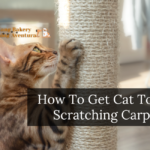Are you fed up with your cat’s habit of using your carpet as a personal scratching post? It’s a common cat behavior, but don’t worry, there are efficient ways to redirect it and keep those unsightly claw marks off your carpet.
In this article, we’ll look at practical techniques to help you understand why your cat scratches the carpet and, more crucially, how to encourage them to use more cat-friendly alternatives.
How To Get Cat To Stop Scratching Carpet?
To address a cat’s tendency to scratch the carpet, provide other outlets for their scratching habit while also discouraging them from attacking the carpet. Here are some tips to assist you stop your cat’s carpet from scratching:
1. Set Up A Horizontal Or Vertical Scratching Pad
Instead of preventing your cat from scratching, provide excellent scratching posts. Otherwise, they will cause damage to your carpets, sofa, and other furnishings, which you do not want. Find simple, wide, and sturdy pads for your cats to enjoy.
When our pets become accustomed to something, they may find it difficult to transition. So, let them choose from a few materials. Allow children to try and choose among those made of cardboard or carpet. Overall, make sure you understand their preferences.
You should also place scratching posts or pads in strategic locations throughout your home where your cat is likely to scratch. If they are movable, your cats will find them less appealing and quit using them.
2. Help Reduce Your Cat’s Stress
Even though it may not appear so, our pets are stressed. They can also become agitated and scratch on objects to relieve their anxiety. You can help them relieve stress by playing with them or simply caressing them. This manner, they will not feel compelled to scratch your carpet.
3. Purchase Scented Carpets
Cats are naturally sensitive to smell and detest certain aromas. If your carpet includes undertones of citron, thyme, banana, and mustard, they will be less likely to scratch it. You may apply the scents by combining them with water and spraying them over your rugs, carpets, and furniture.
4. Give Your Cat Enough Exercise
As previously said, your cats may scratch occasionally to get some exercise. This alone indicates that kids are not getting enough mobility during the day. Giving them exercise by playing with them or keeping them amused might reduce their risks of scratching your carpets.
5. Keep Your Cat’s Claws Short
You can consult your veterinarian on how to groom your cats or take them to a professional. If you prefer to groom cats at home, be sure to choose the best tools for your feline buddy. Furthermore, you should clip your cat’s claws every 10-14 days.
6. Interrupt Them While Scratching
You can distract your cat by simply removing the rugs while he is scratching them. This will plainly communicate that they are not permitted to do so.
7. Put Cover-Up On The Spot Where Your Cat Often Scratches
You can also add a cover to certain carpet sections with double-sided tape or sandpaper. Consider placing a piece of furniture or a scratching post in the area of your carpet where your cat scratches.
8. Thoroughly Clean Your Carpet
Cats are sensitive to smell, thus some scents can cause them to scratch the surface. Cleaning your carpet carefully can eliminate any unpleasant scents that your car may dislike. This can also help erase the marks that cause your cat to scratch. Aside from regular vacuum cleaning, you might consider getting your carpet professionally cleaned.
Reasons Why Cats Scratch
Cats scratch for various reasons, and understanding these motivations will allow you to treat their habit more successfully. Here are some typical reasons cats scratch:
Instinctual Behavior
Cats have an instinctive behavior of scratching. It allows them to stretch their muscles, maintain strong claws, and mark their territory via scent glands in their paws.
Claw Maintenance
Scratching keeps cats’ claws healthy. By shedding the outer layers of their claws regularly, they can reveal the new, sharper claws beneath. This process is vital for a cat’s general health.
Territory Marking
Cats use smell glands in their paws to mark their territory, leaving both visible scratches and scent marks. This allows them to establish and maintain territory while communicating with other cats in the vicinity.
Stretching And Exercise
Cats can stretch and exercise by scratching themselves. It is a type of physical training that helps individuals stay flexible and maintain a general muscular tone.
Emotional Expression
Cats may scratch to communicate their emotions. This could be enthusiasm, annoyance, worry, or even joy. Monitoring other elements of their conduct can aid in determining the emotional context of their scratching.
Grooming Ritual
Cats groom themselves through scratching. It allows them to remove the outer husks from their claws, and they may use scratching posts or other surfaces to aid in this self-grooming process.
Stress Relief
Cats may scratch to release tension and anxiety. Scratching releases endorphins, which act as a cathartic outlet for emotional tension. Understanding and addressing the underlying source of stress might help reduce excessive scratching.
Communication
Cats communicate via scratching with people and other animals. For example, a cat scratching near their food bowl could indicate hunger or displeasure.
Playful Behavior
Kittens may scratch as part of their playful behavior. It helps them hone their hunting and climbing abilities. Providing proper toys and activities might help kids refocus this energy.
Curbing your cat’s tendency to scratch the carpet is straightforward when approached correctly. You can direct your cat’s scratching habits by offering appealing alternatives, selectively employing deterrents, and combining positive reinforcement. Remember, patience and consistency are essential during the training process. With a little effort and knowledge, you can create a happy living situation for both you and your feline partner, keeping your carpet undamaged while satisfying your cat’s natural scratching impulses.
Thanks for reading. I hope you find it interesting.




